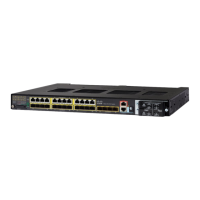819
Configuring IP Unicast Routing
Configuring RIP
DETAILED STEPS
Command Purpose
1. configure terminal Enter global configuration mode.
2. ip routing Enable IP routing. (Required only if IP routing is disabled.)
3. router rip Enable a RIP routing process, and enter router configuration mode.
4. network network number Associate a network with a RIP routing process. You can specify
multiple network commands. RIP routing updates are sent and
received through interfaces only on these networks.
Note: You must configure a network number for RIP commands to take
effect.
5. neighbor ip-address (Optional) Define a neighboring router with which to exchange routing
information. This step allows routing updates from RIP (normally a
broadcast protocol) to reach nonbroadcast networks.
6. offset list [access-list
number | name] {in | out}
offset [type number]
(Optional) Apply an offset list to routing metrics to increase incoming
and outgoing metrics to routes learned through RIP. You can limit the
offset list with an access list or an interface.
7. timers basic update invalid
holddown flush
(Optional) Adjust routing protocol timers. Valid ranges for all timers are
0 to 4294967295 seconds.
update—The time between sending routing updates. The default is
30 seconds.
invalid—The timer after which a route is declared invalid. The
default is 180 seconds.
holddown—The time before a route is removed from the routing
table. The default is 180 seconds.
flush—The amount of time for which routing updates are
postponed. The default is 240 seconds.
8. version {1 | 2} (Optional) Configure the switch to receive and send only RIP Version 1
or RIP Version 2 packets. By default, the switch receives Version 1 and
2 but sends only Version 1.
You can also use the interface commands ip rip {send | receive}
version 1 | 2 | 1 2} to control what versions are used for sending and
receiving on interfaces.
9. no auto summary (Optional) Disable automatic summarization. By default, the switch
summarizes subprefixes when crossing classful network boundaries.
Disable summarization (RIP Version 2 only) to advertise subnet and
host routing information to classful network boundaries.
10. no validate-update-source (Optional) Disable validation of the source IP address of incoming RIP
routing updates. By default, the switch validates the source IP address
of incoming RIP routing updates and discards the update if the source
address is not valid. Under normal circumstances, disabling this feature
is not recommended. However, if you have a router that is off-network
and you want to receive its updates, you can use this command.
11. output-delay delay (Optional) Add interpacket delay for RIP updates sent.
By default, packets in a multiple-packet RIP update have no delay
added between packets. If you are sending packets to a lower-speed
device, you can add an interpacket delay in the range of 8 to 50
milliseconds.

